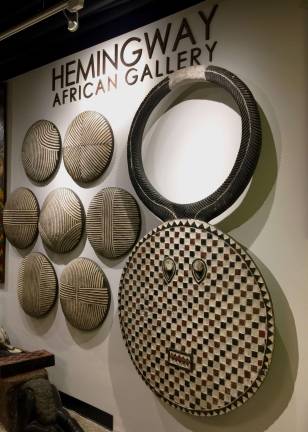inside the hemingway gallery


Of all the places it could have happened, it took place on a Central Park tennis court in the 1970s. That's where a mustachioed South African man named Brian Gaisford met Gregory Hemingway, Ernest Hemingway's youngest son.
The two became friends and in 1975, when Hemingway was looking for a location to host the publisher's party for the book he had written about his father, “Papa: A Personal Memoir.” Gaisford remembered that the place now known as The Manhattan Art and Antiques Center was vacant and he approached Gary Jacobs, the property manager at the time. He asked if they could use the space for the book launch. Jacobs obliged.
Gregory Hemingway's book launch drew a bevy of literati, Norman Mailer included.
Gaisford decorated the event space with African art and by the end of the evening all of the art had sold. He recalls proposing the idea and name for an art gallery to Gregory Hemingway this way:
“Hey, Hemingway African Gallery? And [Gregory] said, 'Well, so long as you don't start a massage parlor.'”
It's been 42 years since that soiree and the Hemingway African Gallery, like its owner and curator, Brian Gaisford, is vernal as ever. In fact, the gallery now occupies two showrooms in The Manhattan Art and Antiques Center, which comprises 100 galleries on Second Avenue in Midtown.
Gaisford's daughter, Logan, works in Gallery 60, on the middle concourse. Of the two galleries, it's the one filled with more contemporary, modern to high modern African art.
As you enter Gallery 60, you are surrounded by an impressive array of Shona sculpture, which has its roots in northern Zimbabwe,.
“You can hear the iron in here. It's amazing, I don't know how they do it. With just a hammer, chisel and sandpaper,” Gaisford said.
“It's an insane amount of work. If American artists were carving these, you wouldn't be able to get them for under $1,000,” Logan added.
At the gallery, prices start at $250.
Wooden fish in a color array like that of a pinwheel are fixed to the wall behind Logan's desk. They are the resultant finds Gaisford made on a trip with a colleague to track desert elephants — one of many animal conservation efforts Gaisford has made over the years.
“These fish, they are actually puppets, they're from a tribe in Mali called the Bozo tribe, and they make these puppets.” Gaisford said. “They live on the Niger River. I found them when I was up in Timbuktu, way up toward the Algerian border. I brought back a bunch of these. Jim Henson from the Muppets used to buy them from us.”
A smaller room is adjoined to the back of Hemingway African Gallery 60. There are several collections of antique tribal art on display that are separated by collection, or by the provenance of the pieces.
When it comes to dating African artwork, Gaisford said “our expertise is to say whether the piece is real or not real. Real means they were made for use by the tribe. They are not tourist pieces, they were made for use.”
Perhaps one of the most interesting facets of Gaisford's enterprise is that if you are intrigued, he will quite literally take you to Africa.
Gaisford, along with Logan and his son Tuck, runs an African safari operation.
“You can come with us for $2,500 up to $5,000, depending on what kind of safari you'd like. But we try to keep costs low so that young people can come. We don't do hunting. We do game capture and educational informing. We feel that by doing the safaris, we have a captive audience to try and teach everybody what's happening in Africa, which sadly, not many other safari companies are doing. Young people are our future conservationists. So we try very hard to keep our costs low. My son and I took 20 orphans from Greenland to Africa. They had never seen a tree before. That was amazing. We also take groups to Greenland, to show them how global warming is really happening. Right there,” Gaisford said.